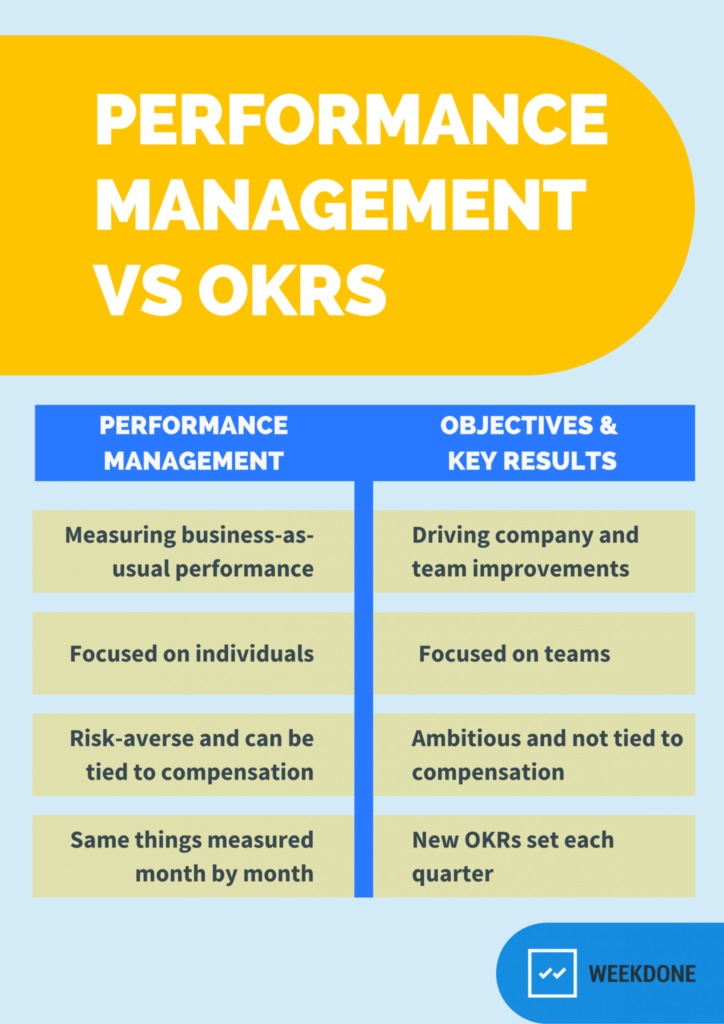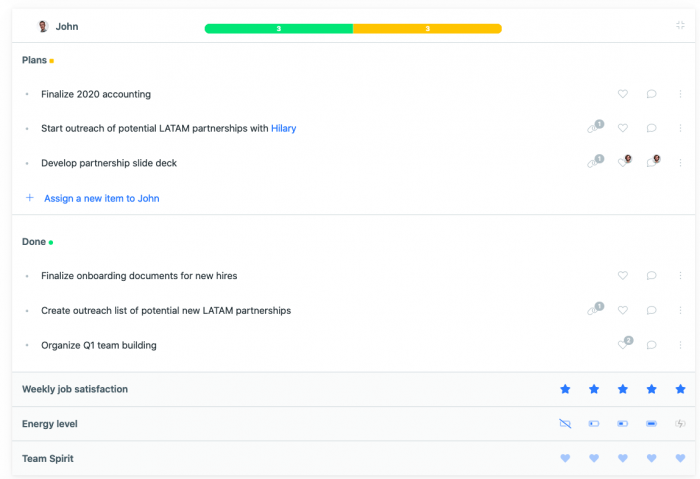Does your team feel motivated and excited to tackle their challenges each day?
If you feel your team has been lacking motivation or needs a boost in performance, one of the best things you can do is to revamp your approach to setting performance goals.
Performance goals are especially useful if you feel your current strategy isn’t working, people are having different levels of performance, or if you’re not having regular goal-setting sessions with your team at all.
In this article, we explore what employee performance goals are, how to set them, and examples of common performance goals.
Also, we’ll suggest an alternative way of measuring employees’ success – OKRs – a goal setting system that lets teams set and manage goals collaboratively and be responsible for the business results.
But first things first…
What Are Employee Performance Goals?
Performance goals are short-term objectives that employees are expected to achieve within a defined period of time. At the top management level, long-term strategic goals are set, and then those goals cascade down throughout the rest of the company to help guide teams and individual performance goals.
Employee performance goals are tied to a specific job position and monetary compensation like promotions, pay raises, and transfers. That way performance goals let employees know what is expected from their position and what they should work toward to earn a pay raise or a new position.
For example, if an employee aims at reaching the position of a team leader, some of their performance goals may be created to include some responsibilities of a team leader. The employer, manager, or department supervisor may define timelines and methods for measuring success.
So it is essential to define performance goals as clearly as possible and make them easily measurable.
Take a look at some performance goal examples below to see how measurable goals can improve employees’ performance.
Doubting if performance goals suit your company culture? Learn about an alternative way to top-down goal setting – OKRs. OKRs are not a performance management tool but an outcome-focused approach to setting team goals and driving progress.
What Are Performance Goals Examples?
Here, we outline some realistic personal and performance goal examples to help employees and managers agree on what would be considered as success:
Employee performance goal example for a marketing manager
- Double our website traffic over the next 12 months by publishing 10 high-quality, targeted blog posts per month;
- Increase the number of MQL’s in our funnel by 20% by the end of Q1 via a targeted email campaign;
- Improve our Net Promoter Score (NPS) by 2 points for the calendar year so that we can improve our referral rate by 10%.
Employee performance goal example for a sales manager
- Increase our MRR (monthly recurring revenue) by 10% within 3 months by improving our cross-selling tactics and customizing our sales pitch to each of our buyer personas;
- Double our monthly booking rate by optimizing all sales email campaigns;
- Increase the average order size to $150 by the end of the year by adding two upselling and cross-selling pitches to every customer interaction.
Employee performance goal example for a product manager
- Create a minimally viable product within 3 weeks to prototype 10 new features;
- Conduct 10 interviews and 20 user feedback surveys to develop a company-wide product strategy;
- Increase same-day on-demand bookings from 10 to 40% of overall bookings across 10 countries.
Employee performance goal example for HR
- Increase the percentage of active job openings filled during the expected deadline from 42% to 55% in 6 months;
- Increase the percentage of workers who give positive feedback about the work environment from 75% in 2021 to 85% in 2022;
- Improve the participation in team-building activities by 30% in the next 6 months by implementing more flexible workshop schedules.
Employee performance goal example for an engineer
- Introduce integration testing to the code by the end of the first month of this quarter;
- Implement API to a monitoring system (I.e. DataDog) by the end of the quarter;
- Improve the load time of an app by two seconds within the next week.
Why Your Team Should Be Setting Performance Goals
Some people assume that goal-setting isn’t important, especially since it’s so common for individuals to fall short of their aspirations. After all, according to the research, only about eight percent of people actually achieve the work performance goals they set for themselves.
There are lots of reasons to make setting performance goals a priority for your team, though, including the following:
Increased Productivity
One of the greatest benefits of regular goal-setting sessions is that they help to keep employees engaged.
When employees are engaged and aren’t just imitating activity, they are much more productive. They get more work done each day, and they tend to do work that’s of a higher value than what they would have done otherwise.
Improved Focus
Workers tend to be more focused when they have specific goals for work evaluation.
When they’re trying to reach a particular milestone, your team members will become more resilient and better able to resist distractions. They might also be able to accomplish certain tasks faster and with more precision. This, in turn, often results in fewer mistakes and better overall work performance.
Better Communication
Regular goal-setting sessions give managers and supervisors an opportunity to get inside their team members’ heads and see what’s most important to them.
Managers get an opportunity to learn more about the people on their team, from their aspirations to their unique talents. Team members can also feel more comfortable talking to higher-ups about their goals and ideas when they have regular opportunities to talk about their plans and aspirations.
This leads to more collaboration and a greater sense of camaraderie for the team as a whole. More collaboration, in turn, can produce better ideas, more productivity, and better work overall.
More Job Satisfaction
Workers who have specific work performance goals that they’re trying to attain often experience higher levels of job satisfaction, too.
If your team members are happy with their jobs and feel fulfilled with the work they do each day, they’re going to be more inclined to stick around long-term. This, in turn, is great for your team and the entire company.
When employees remain loyal, the company also has to spend less money bringing on new team members. Overall productivity and performance tend to improve as well.
How to Set Performance Goals
There are lots of different strategies team leaders and managers can use when it comes to setting performance goals for themselves and those they supervise. The following are some of the most effective approaches to consider using.
Use the SMART method
One method for creating employee performance goals is the SMART framework. It is one of the most popular approaches to use when setting goals. SMART stands for Specific, Measurable, Attainable, Relevant, and Time-Bound.
When setting goals with team members, it’s important to get specific about what they want to accomplish. Supervisors should also clarify the metrics used to determine success, as well as the goals’ attainability and whether or not it’s relevant to the larger mission and objectives of the company.
The goal should have a deadline, too, to hold team members accountable and ensure they’re being as productive as possible as they work to reach it. While this is great for creating employee goals and personal goals specifically, we suggest another method for creating a larger team and company goals.
It’s also important for managers and supervisors to create action plans for their team members. Action plans provide workers with specific steps they can take on their way to reaching their performance goals. Breaking up goals this way helps people to maintain motivation and ensures that they have the necessary tools.
Regular reviews (ideally ones that take place on a weekly basis) are essential, too. These provide accountability for team members and give them a chance to report on their progress.
Weekly reviews also provide an opportunity for team members to ask questions and express concerns. Workers can get feedback on their performance as they work toward their larger objectives, too.
Use OKRs
One way of setting employee goals while keeping teams independent and accountable is the Objectives and Key Results Methodology or OKRs. The purpose of OKRs is to help you focus on what needs to be improved in your company overall.
Whereas SMART goals can be a perfect fit for personal goal-setting within a small team with up to 4 members or an early-stage business, OKRs help to set business goals among 5, 10 or 100 employees at a time.
OKR is a forward-looking goal-setting method that fuels teamwork and accountability. And if you want to see greater collaboration and have your teams truly invested in their work, you should never use OKRs for personal performance management.
OKRs are designed for exploring the unknown and chasing the possibilities that might expose you to a better future. OKRs are not the best tool for setting top-down employee goals and measuring individual performance.
Performance reviews are stressful for both managers and employees, so these ceremonies are often skipped or done superficially. And since they are usually organized 1:1, people tend to focus on task completion and there is no consideration for the bigger picture. This is simply not enough if you would like to improve and grow your business.
Some companies have ditched personal performance reviews completely because they have learned how to get the teams to focus on the outcomes that the organization needs to achieve. When those outcomes are specific enough, clear enough, and motivating enough, teams make better decisions when it comes to prioritizing Objectives and managing their time.
Use OKRs to Set Team Goals
OKR was not designed for performance management, and you shouldn’t think that you can somehow adjust the methodology to serve this purpose. Instead, you should learn how to leverage your teams’ collective intelligence and help them focus on the outcomes that the organization needs to achieve.
Setting OKRs
The O stands for Objectives. These are your big, inspirational goals. These goals can be about growth, change, or innovation and can be used at the Team or Company levels.
An example Objective could be to Increase Customer Engagement.
After setting your Objective, you have to set your Key Results or KRs. These are the measurable outcomes that help you accomplish your Objective
For the previous Objective some example Key Results could be:
- Increase the average customer likes on posts from 28 to 60
Or
- Increase the conversion rate of the blog from 20 to 25%.
The final part of OKRs is your Weekly Plans. These are the activities you accomplish each week to drive your Objectives forward
Implementing OKRs
OKRs should be aligned across the Company. This means you need to think through how you introduce and plan your Company and Team OKRs.
When setting goals with team members, it’s important to get specific about what they want to accomplish. Supervisors should also clarify the metrics used to determine success, as well as the goals’ attainability and whether or not it’s relevant to the larger mission and objectives of the company.
The goal should have a deadline, too, to hold team members accountable and ensure they’re being as productive as possible as they work to reach it. At the end of the quarter, you should hold an OKR review.
Using OKR Software
While OKRs are one of the best means for setting performance and development goals, it’s important to do OKRs correctly from the start by using an OKR software like Weekdone.
Weekdone users get access to free OKR coaching, training, and team onboarding to help you and your company learn OKRs as quickly as possible.
You can get started testing out OKRs and the software for free.
Wrap Up
It is important to set motivating and engaging performance goals. Hopefully, this article has set you on the right path for helping your team achieve their goals.
Now you know what performance goals are, when it’s reasonable to set them, and what some examples of the performance goals you could use.
You’ve also seen a few alternative methods for setting performance goals such as SMART goals and OKR goals.
Using SMART goals helps you define performance goals and measure employee performance within a specific timeline. It’s a good fit for small teams or personal goal tracking within a team.
Using OKRs helps you set team goals, define a focus area, and deliver measurable outcomes collaboratively. It’s a good fit for growing teams and outcome-focused company culture.
In case you’re interested in diving deeper into OKRs and how to use them for performance goals, take a look at:
- OKR Examples: See examples of OKRs that you can use as a reference when coming up with your own;
- What benefits OKRs can bring you and your team;
- Why to use team OKRs instead of personal goal setting;
- How to achieve team alignment using OKRs for setting and tracking goals.


